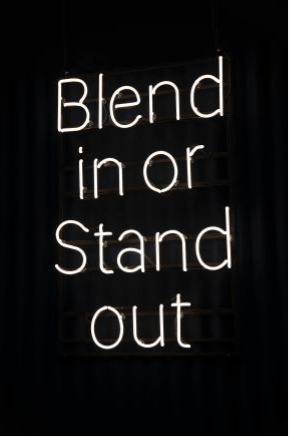*Brand identity
Determining Brand Identity: The Fundamentals

Brand identity is the face of your brand. It is the visual introduction to your product. This visual introduction immediately triggers associations in the mind of your potential customer. And that’s where the challenge lies. How do you ensure that these associations align with the characteristics and values of your brand? In this article, we help you determine your brand identity.
The Importance of a Clear Brand Identity

Let’s start by looking at the definition of brand identity:
“The visual elements of a company through which the distinctive core values are communicated to the market.”
Brand identity is essentially your communication with the market. It is the first and most important asset that can convince and persuade customers to use your product or service. A good brand identity is recognizable and consistent. It tells your customer what to expect from your product. In competitive markets with many similar products, this can be a challenge for many businesses. How do you translate the values, characteristics, and distinctiveness of your brand into visual elements?
Before determining your brand identity, it’s important to position your brand well in the market. Knowledge of the market and competition is essential if you want to stand out. If you have no idea what your company stands for or how to position yourself in the market, it makes little sense to design a logo or slogan for your company. We delve into this extensively on the “Positioning” page. Based on your positioning, you can then determine your brand identity.
Determining Brand Identity
Determining your brand identity is based on the insights gained from your positioning. Two components are important here: what are the core values of your company, and what are the needs of the target audience. A good brand identity is based on these elements. What does your company stand for? Porsche stands for luxury and speed, while Volvo has safety as a core value. The communication materials of these companies reflect these values. Determine the core values of your company and how you can incorporate them into your brand identity.
In addition, the needs of your target audience are important. Porsche’s target audience is sensitive to status and innovation, while potential Volvo drivers are more conservative and prioritize reliability. This involves some market research. Also, look at market trends. Markets and consumer needs are constantly evolving. Adapt to them. Paying attention to customer needs and market development forces you to think creatively when determining a brand identity. This way, you are not only prepared for today but also for the future.
Describing and Defining Brand Identity
Once you’ve mapped out all your characteristics – both positive and negative – describe in one sentence the associations your new brand identity evokes. Then, you’ll give these characteristics a visual representation to conquer the market. The key elements of a brand identity are as follows:
- Typeface
- Color
- Logo
- Tone of Voice
- Imagery
Together, these elements should visually represent your distinctive characteristics. We’ll provide a brief explanation of how to approach each element:
Typeface
A typeface can be bold or thin, spaced out or connected, simple or complex, large or small, serif or sans-serif. Psychologically, these letter attributes influence customer perceptions. If you have a rugged, masculine brand, don’t choose a font with serifs or a delicate, connected typeface.
Color
Colors evoke feelings. It’s no accident that many market leaders in various industries use blue. Blue signifies trust, strength, and reliability. Orange is associated with friendliness, cheerfulness, and trust. Red conveys excitement, youthfulness, and courage. Choose colors that align with your brand’s distinguishing strengths.
Logo
In a logo, color, typeface, and shape come together. The right combination of shape and color triggers an emotional response that matches a brand’s character.
Tone of Voice
Tone of voice is how you communicate with your customers. The most common example is whether to use formal or informal language in your communication. Are you on equal footing with your customers or positioned above them? Tone of voice gives your content personality and sets it apart. Tone can transform even the dullest production process into a technological marvel. Harness the power of language. Its psychological impact is just as significant as color and shape.
Imagery
Photography and video significantly influence the associations and emotions customers have with a brand. It’s about making a brand recognizable based on these visual aspects. Do you use busy or serene images on your website? The true leaders in this regard use imagery so recognizable that consumers can instantly identify the brand.
If you want to learn more about the elements of brand identity and how to use them psychologically to strengthen your brand, read our brand identity page.
